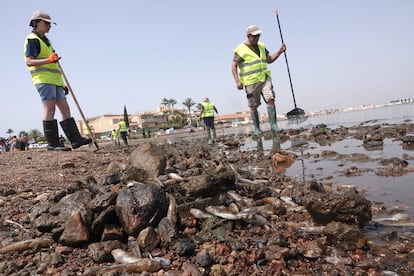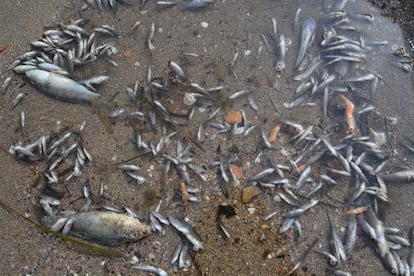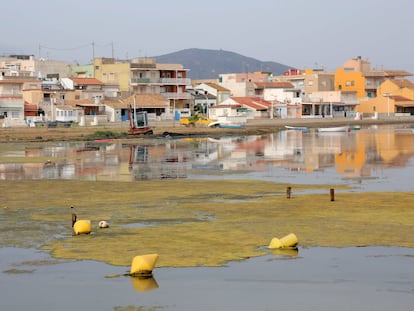Some 250 kilos of dead fish wash up in Murcia’s Mar Menor
Marine life suffocating due to a lack of oxygen has come to symbolize the environmental collapse of Europe’s largest saltwater lagoon, but the regional government says this episode was not caused by anoxia

On Sunday evening, small dead fish began to appear on the beaches in the southern part of the Mar Menor, a lagoon located in the Murcia region near Cartagena. Residents were quick to point to what happened in October 2019, when thousands of dead fish washed up on the shores, having been asphyxiated due to a lack of oxygen. This time, however, the episode is on a smaller scale, and so far around 250 kilos of young fish and some crustaceans have been recovered – in 2019, three tons of dead animals washed up.
Fish suffocating due to a lack of oxygen has come to symbolize the environmental collapse of Mar Menor, which is the largest saltwater lagoon in Europe. After the episode in 2019, experts put the disaster down to the management of the land surrounding the lagoon, which covers 17,000 hectares. More specifically, they blame intensive farming for contaminating the soil and the groundwater with nitrates from fertilizers, which end up in the Mar Menor, causing eutrophication. This happens when there is an excessive amount of nutrients in the water, provoking the growth of phytoplankton which reduces the amount of oxygen.
Ruling out anoxia without having adequate monitoring systems in place for this variable lacks scientific rigorJuan Manuel Ruiz, research professor at the CSIC-Spanish Oceanographic Institute
Murcia’s regional government has stated that the data collected this time around by scientists at the Cartagena Polytechnic University rules out that this was due to a lack of oxygen, nor have any toxic substances been detected. There has, however, been a rise in the temperature of the water in the area, which has gone from 28.5ºC to 31ºC in just two days. According to a spokesperson from the university, this could be the cause of the phenomenon.
Environmental organizations in the area, however, have vehemently rejected this official explanation. They suggest instead that the ecosystem has deteriorated and that a lack of oxygen is the most plausible explanation.
Ángel Pérez Ruzafa, an ecology professor at the University of Murcia, believes that the high temperatures have been combined with the arrival of superficial and subterranean waters that are “heavily loaded with nutrients.” His team, which works with the Murcia regional government, has only located low oxygen levels in a couple of places in the area. “There has not been general anoxia, but there is enough for sensitive organisms to notice it,” he explains. The episode has, as such, affected creatures such as shrimp, among others, but not eel or sea bream. In his opinion, a repeat episode cannot be ruled out.

Juan Manuel Ruiz, a research professor at the CSIC-Spanish Oceanographic Institute, argues that “ruling out anoxia without having adequate monitoring systems in place for this variable lacks scientific rigor.” He points out that a shortage of oxygen in just one part of the lagoon is enough for organisms in that area to die and later wash up on the beaches.
The regional government, which is run by the conservative Popular Party (PP) in coalition with center-right Ciudadanos (Citizens), has announced that it is going to file a lawsuit with the public prosecutor “so that [Minister for the Ecological Transition of Spain] Teresa Ribera is investigated for her inaction and lack of application of measures that contribute to the protection and recovery of the Mar Menor, and after her decision to abandon it, allowing 30,000 cubic meters of fresh water and 5,857 kilos of nutrients to enter the ecosystem every day.” According to data from the regional government, since November 2019, 19 million cubic meters of water have entered the area as well as 3.7 million kilos of nutrients.
Isabel Rubin, the spokesperson for Pacto por el Mar Menor, an organization that is fighting to improve the state of the lagoon, has criticized the attitude of the regional government. “It’s somewhat shocking,” she says. “[The] Murcia [regional government] has a lot of powers and in the nearly six years that we have been going, no steps have been taken to solve the origin of the problem, which is the products being used in agriculture.” She also denounces the fact that there are no controls on which chemicals can be used on crops.
English version by Simon Hunter.
Tu suscripción se está usando en otro dispositivo
¿Quieres añadir otro usuario a tu suscripción?
Si continúas leyendo en este dispositivo, no se podrá leer en el otro.
FlechaTu suscripción se está usando en otro dispositivo y solo puedes acceder a EL PAÍS desde un dispositivo a la vez.
Si quieres compartir tu cuenta, cambia tu suscripción a la modalidad Premium, así podrás añadir otro usuario. Cada uno accederá con su propia cuenta de email, lo que os permitirá personalizar vuestra experiencia en EL PAÍS.
¿Tienes una suscripción de empresa? Accede aquí para contratar más cuentas.
En el caso de no saber quién está usando tu cuenta, te recomendamos cambiar tu contraseña aquí.
Si decides continuar compartiendo tu cuenta, este mensaje se mostrará en tu dispositivo y en el de la otra persona que está usando tu cuenta de forma indefinida, afectando a tu experiencia de lectura. Puedes consultar aquí los términos y condiciones de la suscripción digital.
More information
Últimas noticias
Most viewed
- Reinhard Genzel, Nobel laureate in physics: ‘One-minute videos will never give you the truth’
- Oona Chaplin: ‘I told James Cameron that I was living in a treehouse and starting a permaculture project with a friend’
- Pablo Escobar’s hippos: A serious environmental problem, 40 years on
- Chevy Chase, the beloved comedian who was a monster off camera: ‘Not everyone hated him, just the people who’ve worked with him’
- Why we lost the habit of sleeping in two segments and how that changed our sense of time











































